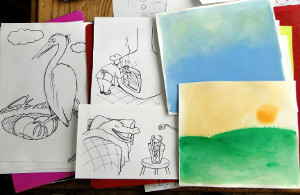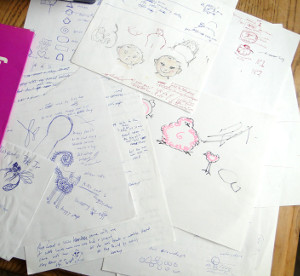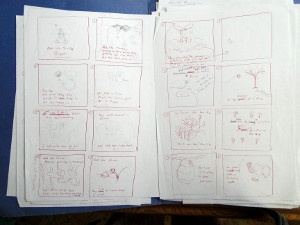The Creative Process - A Look at How My Books are Conceived and Created
 The first idea that leads to a finished book could be anything-- a character, a rough sketch, a rhyme or even a painting style, and can come from anywhere-- a memory from childhood, something someone says, things I see at the supermarket, in nature and especially things that kids do and say. Kids are nutty, I am privileged to have the opportunity to listen and learn from them (and steal their ideas!). I don't always start with the story, sometimes an illustration comes first. Generally, I start out with a style of illustration in mind but invariably, the book goes in another direction and I have to adapt to accommodate it. My planning sketches are loose at best and the process reminds me more of sculpting than illustrating. Never in order, I chip away at each page. I usually start with the page for which I have the strongest idea or the clearest concept and every consequent page has to try and maintain some kind of continuity of style. This means that I always end up going back to the earlier pages to adjust elements correct and perfect. This is the process I call "infinite tweaking" because when I think I'm finished illustrating, there is usually another month before I'm really finished. This was exhausting in the beginning, but now I accept it as part of the process.
The first idea that leads to a finished book could be anything-- a character, a rough sketch, a rhyme or even a painting style, and can come from anywhere-- a memory from childhood, something someone says, things I see at the supermarket, in nature and especially things that kids do and say. Kids are nutty, I am privileged to have the opportunity to listen and learn from them (and steal their ideas!). I don't always start with the story, sometimes an illustration comes first. Generally, I start out with a style of illustration in mind but invariably, the book goes in another direction and I have to adapt to accommodate it. My planning sketches are loose at best and the process reminds me more of sculpting than illustrating. Never in order, I chip away at each page. I usually start with the page for which I have the strongest idea or the clearest concept and every consequent page has to try and maintain some kind of continuity of style. This means that I always end up going back to the earlier pages to adjust elements correct and perfect. This is the process I call "infinite tweaking" because when I think I'm finished illustrating, there is usually another month before I'm really finished. This was exhausting in the beginning, but now I accept it as part of the process.
 I have a "conception" folder. I do feel that when I open it, all the ideas come rushing out so I'm a bit scared of it. I try to keep it closed when I'm working on a specific project. When I'm illustrating or doing my marketing I never think of new ideas for books, it gets too distracting. I just shut off that part of my brain and hope it still works when I need it. When I sit down to brainstorm ideas, brainstorm is a good word to describe the process. I usually end up with loads of random stuff on pieces of paper, all unrelated, some rhymes, some story lines or just a character's name or a book title that I like, or whatever... Sometimes one idea will be stronger and I will follow it 'til it runs out of steam. At the end there's a lot of paper and a lot of semi-coherent notes and sketches that all get gathered up and go in the conception folder.
I have a "conception" folder. I do feel that when I open it, all the ideas come rushing out so I'm a bit scared of it. I try to keep it closed when I'm working on a specific project. When I'm illustrating or doing my marketing I never think of new ideas for books, it gets too distracting. I just shut off that part of my brain and hope it still works when I need it. When I sit down to brainstorm ideas, brainstorm is a good word to describe the process. I usually end up with loads of random stuff on pieces of paper, all unrelated, some rhymes, some story lines or just a character's name or a book title that I like, or whatever... Sometimes one idea will be stronger and I will follow it 'til it runs out of steam. At the end there's a lot of paper and a lot of semi-coherent notes and sketches that all get gathered up and go in the conception folder.
Sometimes I just start straight in illustrating, and if something viable comes out then the book grows from there. I don't recommend this method of working and if you study children's book illustration, you will be given much more logical ways of organising your work flow, but I don't believe you should fight against your nature and mine is just messy.  If I do write the story first, I then break up the text into chunks and think of the best combination of story and picture for each page, and do a kind of storyboard with text and image keeping in mind elements like, facing pages of the print book, surprise elements of the story, that need to appear on the turned page. I like the double spread illustration but I try to keep each single page independent also, to then be able to have a universal ebook format that doesn't rely on facing pages. My story board is very crude. It is only to show the page composition, and roughly what's happening on each page. Then, if I haven't already done so, I start building a page of illustration, leaving a clear part of the page where the text will go later. I make the cover when the book is totally finished because the essence of the book and the message you want it to give is sometimes unclear until you see it completed. The cover is the most import element of the book in commercial terms - no one will eat the cake if they don't like the frosting! So, I usually do a few mock-ups and get feedback before I decide on one.
If I do write the story first, I then break up the text into chunks and think of the best combination of story and picture for each page, and do a kind of storyboard with text and image keeping in mind elements like, facing pages of the print book, surprise elements of the story, that need to appear on the turned page. I like the double spread illustration but I try to keep each single page independent also, to then be able to have a universal ebook format that doesn't rely on facing pages. My story board is very crude. It is only to show the page composition, and roughly what's happening on each page. Then, if I haven't already done so, I start building a page of illustration, leaving a clear part of the page where the text will go later. I make the cover when the book is totally finished because the essence of the book and the message you want it to give is sometimes unclear until you see it completed. The cover is the most import element of the book in commercial terms - no one will eat the cake if they don't like the frosting! So, I usually do a few mock-ups and get feedback before I decide on one.
Depending on the detail involved, number of pages and time available, illustrating usually takes me about 3 months, then a month or so for editing, creating front and end matter (copyright pages etc.) beta testing, copywriting and so on. I make the print version first because generally speaking it's more demanding. Then the various ebook versions.
My technical guy produces ebooks with high resolution and a fixed layout. I don't like to have the text separate to the image. It is too unpredictable and can ruin the reading experience. I try to have the highest possible quality images while keeping my file sizes small, which means working closely with my techie guy to produce the digital books that can be read on as many devices as possible. Unlike many children's book authors, I have embraced the ebook. The satisfaction of seeing your illustration in the rich, bright colour of RGB on screen as you intended them to be seen is really nice. Also, I find that for sending review copies, sharing your work with people on the other side of the world and a million ways of showcasing your work, ebooks are a necessity. I am incredibly lucky to be able to leave that job to people who REALLY know what they are doing and refuse to produce anything less than the best quality. On the print side, books are printed with a different colour palette with fewer colours with less brightness and intensity, so if you compare digital to print, some colours in print seem dull (especially green). However, the satisfaction of seeing your book in print for the fist time is indescribable and is one of the best parts of the book making process.
